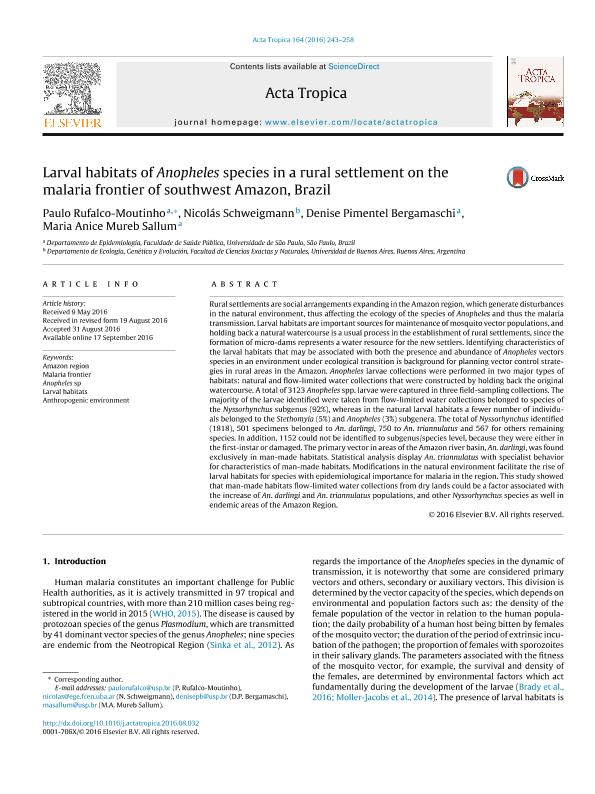Mostrar el registro sencillo del ítem
dc.contributor.author
Rufalco-Moutinho, Paulo
dc.contributor.author
Schweigmann, Nicolas Joaquin

dc.contributor.author
Bergamaschi, Denise Pimentel
dc.contributor.author
Mureb Sallum, Maria Anice
dc.date.available
2018-10-01T19:35:14Z
dc.date.issued
2016-12
dc.identifier.citation
Rufalco-Moutinho, Paulo; Schweigmann, Nicolas Joaquin; Bergamaschi, Denise Pimentel; Mureb Sallum, Maria Anice; Larval habitats of Anopheles species in a rural settlement on the malaria frontier of southwest Amazon, Brazil; Elsevier Science; Acta Tropica; 164; 12-2016; 243-258
dc.identifier.issn
0001-706X
dc.identifier.uri
http://hdl.handle.net/11336/61431
dc.description.abstract
Rural settlements are social arrangements expanding in the Amazon region, which generate disturbances in the natural environment, thus affecting the ecology of the species of Anopheles and thus the malaria transmission. Larval habitats are important sources for maintenance of mosquito vector populations, and holding back a natural watercourse is a usual process in the establishment of rural settlements, since the formation of micro-dams represents a water resource for the new settlers. Identifying characteristics of the larval habitats that may be associated with both the presence and abundance of Anopheles vectors species in an environment under ecological transition is background for planning vector control strategies in rural areas in the Amazon. Anopheles larvae collections were performed in two major types of habitats: natural and flow-limited water collections that were constructed by holding back the original watercourse. A total of 3123 Anopheles spp. larvae were captured in three field-sampling collections. The majority of the larvae identified were taken from flow-limited water collections belonged to species of the Nyssorhynchus subgenus (92%), whereas in the natural larval habitats a fewer number of individuals belonged to the Stethomyia (5%) and Anopheles (3%) subgenera. The total of Nyssorhynchus identified (1818), 501 specimens belonged to An. darlingi, 750 to An. triannulatus and 567 for others remaining species. In addition, 1152 could not be identified to subgenus/species level, because they were either in the first-instar or damaged. The primary vector in areas of the Amazon river basin, An. darlingi, was found exclusively in man-made habitats. Statistical analysis display An. triannulatus with specialist behavior for characteristics of man-made habitats. Modifications in the natural environment facilitate the rise of larval habitats for species with epidemiological importance for malaria in the region. This study showed that man-made habitats flow-limited water collections from dry lands could be a factor associated with the increase of An. darlingi and An. triannulatus populations, and other Nyssorhynchus species as well in endemic areas of the Amazon Region.
dc.format
application/pdf
dc.language.iso
eng
dc.publisher
Elsevier Science

dc.rights
info:eu-repo/semantics/openAccess
dc.rights.uri
https://creativecommons.org/licenses/by-nc-nd/2.5/ar/
dc.subject
Amazon Region
dc.subject
Anopheles Sp
dc.subject
Anthropogenic Environment
dc.subject
Larval Habitats
dc.subject
Malaria Frontier
dc.subject.classification
Otras Ciencias Biológicas

dc.subject.classification
Ciencias Biológicas

dc.subject.classification
CIENCIAS NATURALES Y EXACTAS

dc.title
Larval habitats of Anopheles species in a rural settlement on the malaria frontier of southwest Amazon, Brazil
dc.type
info:eu-repo/semantics/article
dc.type
info:ar-repo/semantics/artículo
dc.type
info:eu-repo/semantics/publishedVersion
dc.date.updated
2018-10-01T16:09:45Z
dc.journal.volume
164
dc.journal.pagination
243-258
dc.journal.pais
Países Bajos

dc.journal.ciudad
Amsterdam
dc.description.fil
Fil: Rufalco-Moutinho, Paulo. Universidade de Sao Paulo; Brasil
dc.description.fil
Fil: Schweigmann, Nicolas Joaquin. Universidad de Buenos Aires. Facultad de Ciencias Exactas y Naturales. Departamento de Ecología, Genética y Evolución. Grupo de Estudio de Mosquitos; Argentina. Consejo Nacional de Investigaciones Científicas y Técnicas. Oficina de Coordinación Administrativa Ciudad Universitaria. Instituto de Ecología, Genética y Evolución de Buenos Aires. Universidad de Buenos Aires. Facultad de Ciencias Exactas y Naturales. Instituto de Ecología, Genética y Evolución de Buenos Aires; Argentina
dc.description.fil
Fil: Bergamaschi, Denise Pimentel. Universidade de Sao Paulo; Brasil
dc.description.fil
Fil: Mureb Sallum, Maria Anice. Universidade de Sao Paulo; Brasil
dc.journal.title
Acta Tropica

dc.relation.alternativeid
info:eu-repo/semantics/altIdentifier/url/http://www.sciencedirect.com/science/article/pii/S0001706X16302637
dc.relation.alternativeid
info:eu-repo/semantics/altIdentifier/doi/http://dx.doi.org/10.1016/j.actatropica.2016.08.032
Archivos asociados
